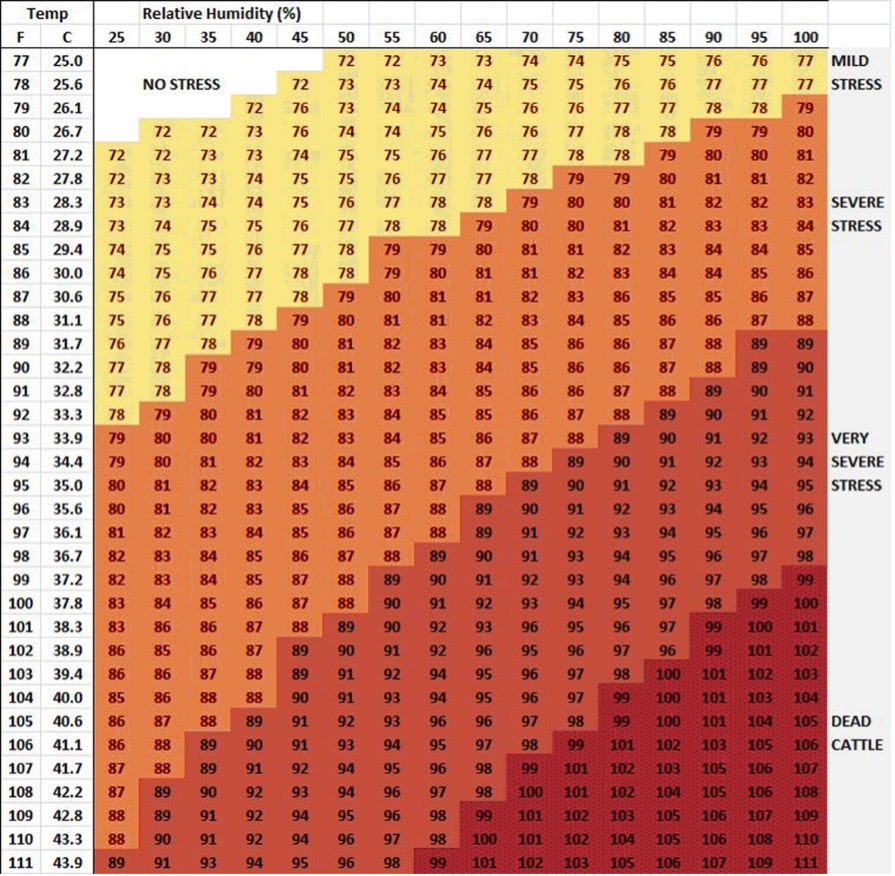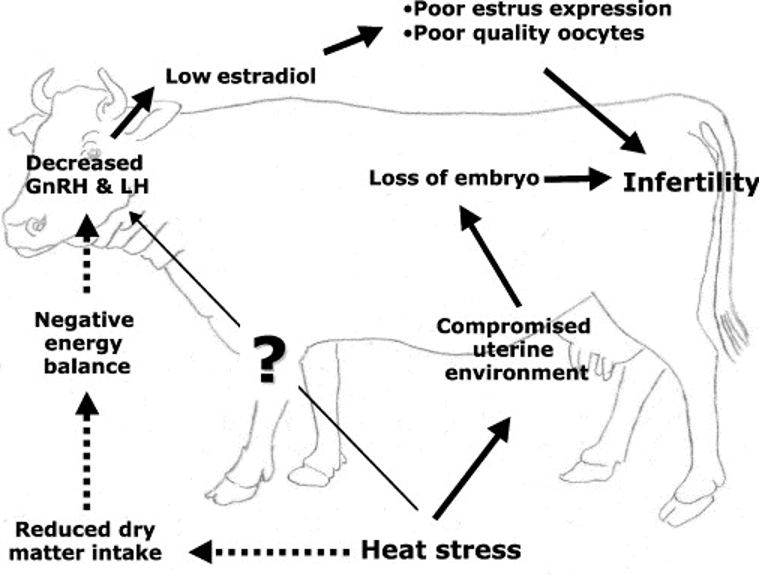Source: Utah State University
Introduction
Reproduction could be considered the most important production trait on a cow-calf operation. Economic outputs are sustained when cattle rebreed and calve every year in a timely manner. However, when cattle are unable to rebreed efficiently, profits may decrease for producers. It is well known that heat stress can negatively impact reproduction in cattle (Jordan, 2003). The Intermountain West has been impacted by drought and increasing temperatures, both of which can impact reproduction rates in cattle. It is important to understand the consequences of heat stress on cattle reproduction and how producers can manage reproduction during increasing temperatures.

Heat Stress Defined
Heat stress is commonly defined as occurring when the temperature humidity index (THI) exceeds 72 (see Figure 1). The THI considers the ambient temperature and amount of humidity. Cattle can easily become heat-stressed because they do not have the ability to sweat effectively and because the rumen acts as an added heat source through fermentation.
Figure 1 Note. From Veterinary Handbook for Cattle, Sheep, and Goats by The Australian Livestock Export Corporation (LiveCorp) and Meat and Livestock Australia (MLA), http://www.veterinaryhandbook.com.au. Copyright 2021 by LiveCorp. Used with permission.
According to the Agricultural Research Service (ARS), U.S. Department of Agriculture, there are six stages of heat stress (see Table 1). Interesting to note in Table 1, and counterintuitive to some, is the fact that cattle tend to bunch together in the early stages of heat stress due to their herding instinct. Recognizing these stages and providing early intervention is key to increasing the comfort and possibly the survival of cattle experiencing heat stress. Problems from heat stress often present themselves during times of stress, like handling, transporting, or moving cattle. When noticing heat-stress signs, minimize stressors. Handle animals using low-stress techniques, offer water, and if applicable, decrease stocking density.
Table 1. Cattle Heat Stress Stages and Clinical Signs
| Stage 1 | Increased time standing, elevated breathing, restlessness. |
|---|---|
| Stage 2 | Increased time standing, animals grouped together, elevated breathing, drooling, restlessness. |
| Stage 3 | Increased time standing, animals grouped together, elevated breathing, excessive drooling or foaming, restlessness. |
| Stage 4 | Increased time standing, open-mouth breathing, elevated breathing, possible drooling, restlessness. |
| Stage 5 | Elevated breathing with pushing from flanks; open-mouth breathing with tongue protruding; increased time standing; animals grouped together. |
| Stage 6 | Open-mouth breathing with tongue protruding; breathing is labored and respiration rate may decrease; cattle push from flanks while breathing, head down, not necessarily drooling; individual animals may be isolated from herd. |
Note. Adapted from “Recognizing Heat Stress,” Agricultural Research Service, U.S. Department of Agriculture at ars.usda.gov.
How Heat Stress Impacts Reproduction
Typically, breeding season for spring calving herds is during the hot summer months in the Intermountain West. When cattle are experiencing heat stress, there is an increase in the stress hormone cortisol. Cortisol decreases essential reproductive hormones such as estradiol (Hansen & Aréchiga, 1999). Decreased estradiol reduces the duration and intensity of estrus, also known as heat. Additionally, decreased estradiol results in a rise in silent ovulations and decreased mounting activity (see Figure 2; Rensis & Scaramuzzi, 2003). Conception rates and pregnancy rates from artificial insemination (AI) are decreased in heat-stressed cattle. This is the case for both timed AI (TAI) and synchronizing with heat detection. However, producers may see increased conception rate in cattle using TAI because more cattle will be serviced. Synchronizing with heat detection may be less effective since heat stress causes a decrease in heat detection because of decreased estrus activity (Cartmill et al., 2001).
Other important reproductive hormones can be negatively affected by heat stress, such as luteinizing hormone (LH) and gonadotropin releasing hormone (GNRH). Both LH and GNRH are reduced as a result of negative energy balance in cattle. As temperatures rise, cattle do not consume as much dry matter, resulting in a lower plane of nutrition. If the reduction in dry matter is severe enough, cattle can enter a negative energy balance, suppressing reproduction processes (Figure 2).

Heat stress also results in decreased blood flow to the uterus. This can increase early embryonic loss because of unfavorable uterine conditions. Depending on the severity of heat stress, the hormone progesterone can be decreased. Progesterone is the hormone that maintains pregnancy, and when progesterone decreases, fertility also decreases as a result of early embryonic loss (Figure 2; Rensis & Scaramuzzi, 2003).
Bulls’ fertility is also affected by heat stress. Ideally, sperm forms below body temperature. The scrotum and spermatic cord muscles act as a thermoregulatory tool by increasing or decreasing testis distance from the body depending on ambient temperature. However, rising temperatures may exceed this thermoregulatory ability resulting in testis temperature at which sperm is formed. Increased temperatures during sperm formation can reduce the quality of sperm which in turn decreases fertility (Rensis & Scaramuzzi, 2003). Along with fertility, bull behavior is altered by heat stress. When temperatures rise, bulls can be found resting in the shade. If shade is not present, bulls can be found resting by water sources. Bulls will spend less time grazing and breeding during daylight hours when temperatures are high (Titto et al., 2011). In short, heat stress lowers libido in bulls which can decrease pregnancy rates of cows (Bhakat et al., 2014).
How to Mitigate the Effects of Heat Stress
Preventing the effects of heat stress begins before the breeding season starts. It is important that cattle are already at an ideal body condition score (BCS), which is considered 5 to 6 for beef cattle (Morrison et al., 1999), before breeding season to ensure that they can partition nutrients toward reproduction. Heat stress and stress, in general, take energy, drawing away nutrients from important systems such as the reproductive system. When animals are heat-stressed, they use energy to maintain homeostasis. In addition to decreased intake, increased energy demand during heat stress results in decreased body weight. Using BCS is an easy way to measure body condition subjectively without weighing cattle (Lees et al., 2019). Additionally, it has been shown that offering cattle vitamins and minerals in advance of breeding season can help in mitigating the effects of heat stress on reproduction (Hansen, 1999).
During the breeding season, producers can ensure that cattle are maintaining dry matter intake. As mentioned before, heat stress decreases dry matter intake, which in turn decreases fertility. A possible solution to this is offering cattle feed during cooler times of the day. Increasing dry matter intake for grazing cattle starts with proper pasture management. Often, times of rising temperatures are accompanied by drought. Evaluating stocking rates is essential in making sure animals have access to adequate amounts of feed. If stocking rates are too high during drought years, cattle may run out of feed which will decrease dry matter intake.
Producers can also offer shade to minimize heat stress in cattle. Shade can come from trees in a pasture or from manufactured structures. In range settings, managing heat stress is harder to control. However, there are still practices that can help decrease heat stress on the range. Working or moving cattle early in the day is one way to reduce heat stress for range cattle. For all cattle, one of the most important things to consider when temperatures rise is ensuring an adequate source of palatable water. Make sure water troughs are large enough for many cattle to gather around to drink. Water could be considered the most important nutrient for cattle. For example, during the summer months, lactating cattle could require up to 35 gallons of water per day.
Conclusion
Since reproductive success on a cow-calf operation is essential, it is important to know and understand factors that affect reproduction. Heat stress can be a major factor in reproductive rates, especially during hot, dry years. Preparation for breeding season is key to minimize the negative effects of heat stress on reproduction. If producers are prepared and understand the consequences of heat stress, the breeding season can have positive outcomes.
References
- Agricultural Research Service. (2017). Recognizing heat stress. U.S. Department of Agriculture. https://www.ars.usda.gov/plains-area/clay-center-ne/marc/docs/heat-stress/recognizing-heat-stress/.
- Bhakat, M., Mohanty, T. K., Gupta, A. K., & Abdullah, M. (2014). Effect of season on semen quality of crossbred (Karan Fries) bulls. Advances in Animal and Veterinary Sciences, 2(11), 632–637. https://doi.org/10.14737/journal.aavs/2014/2.11.632.637
- Cartmill, J. A., El-Zarkouny, S. Z., Hensley, B. A., Rozell, T. G., Smith, J. F., & Stevenson, J. S. (2001). An alternative AI breeding protocol for dairy cows exposed to elevated ambient temperatures before or after calving or both. Journal of Dairy Science, 84(4), 799–806. https://doi.org/10.3168/jds.s0022-0302(01)74536-5
- Hansen, P. J., & Aréchiga, C. F. (1999). Strategies for managing reproduction in the heat-stressed dairy cow. Journal of Animal Science, 77(suppl_2), 36. https://doi.org/10.2527/1997.77suppl_236x
- Jordan, E. R. (2003). Effects of heat stress on reproduction. Journal of Dairy Science, 86. https://doi.org/10.3168/jds.s0022-0302(03)74043-0
- Lees, A. M., Sejian, V., Wallage, A. L., Steel, C. C., Mader, T. L., Lees, J. C., & Gaughan, J. B. (2019). The impact of heat load on cattle. Animals, 9(6), 322. https://doi.org/10.3390/ani9060322
- Morrison, D. G., Spitzer, J. C., & Perkins, J. L. (1999). Influence of prepartum body condition score change on reproduction in multiparous beef cows calving in moderate body condition. Journal of Animal Science, 77(5), 1048. https://doi.org/10.2527/1999.7751048x
- Rensis, F. D., & Scaramuzzi, R. J. (2003). Heat stress and seasonal effects on reproduction in the dairy cow—a review. Theriogenology, 60(6), 1139–1151. https://doi.org/10.1016/s0093-691x(03)00126-2
- Titto, C. G., Titto, E. A., Titto, R. M., & Mourao, G. B. (2011). Heat tolerance and the effects of shade on the behavior of Simmental bulls on pasture. Animal Science Journal, 82(4), 591–600. https://doi.org/10.1111/j.1740-0929.2011.00872.x
Authors
Reganne Briggs, M.S. and Kerry A. Rood, M.S., DVM, MPH, DACVPM









